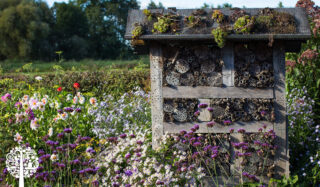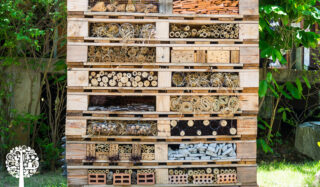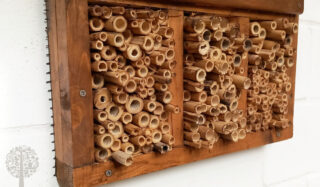We build birdhouses for the chickadees, swallows, and robins that call our gardens home. We set up mason bee houses for the busy pollinators that preserve biodiversity. But what about other kinds of bugs? Some, like aphids, are pests that destroy flowers and vegetables, but others are beneficial. An insect hotel is a great way to pamper them after a hard day. Here are some tips on creating a simple, cozy insect habitat to offer the best accommodation for ladybugs, lacewings, and more.

Insect Hotels
An insect hotel is a natural space or man-made structure providing shelter for hibernating or nesting insects. If you build it big enough, the hotel can also welcome frogs and newts!
It can be as simple as moving a few rotting logs into a secluded garden corner and laying down decaying leaves, twigs, and branches. Or, it can be a three-tiered structure built out of natural or recycled materials, such as old pallets, pots, or clay tiles, and divided into separate zones for different insects. It can be a stand-alone structure or small enough to attach to a fence post.
A homemade insect hotel’s size, shape, and aesthetics are limitless. Ensure it has a solid back and a roof to keep the inside dry. The hotel’s front must be open but covered with chicken wire or mesh to allow guests in and keep hungry birds and rodents away.

It can be a disc shape, triangle, cylindrical, square, or just some recycled pots and wood stacked together.
Location, Location, Location
Where you put your insect hotel will make a difference to what bugs it attracts and how cozy it is.
A sheltered area away from the wind is optimal. Most insects prefer damp and dark conditions, so a sun-part shade spot makes sense.
Putting the hotel close to an active insect area, such as a hedge, a bank of nectar-rich flowers such as bee balm, or a pond will help it fill up quickly.
Attracting Guests
Decorating the rooms of your insect hotel is the creative part. Different insects will prefer different furnishings.
Wood-Boring Beetles & Centipedes
Rotting logs are perfect for wood-boring beetles whose larvae feast on decaying wood. Mixed with other decaying plant matter, such as leaves, the logs will also attract centipedes who eat slugs, millipedes, and woodlice.
Ground Beetles & Ladybugs
Various stick sizes and twigs attract ground beetles who chase aphids and carrot root fly larvae. Ladybugs will also check into this space, and that’s great, as they also snack on aphids and mites.
Hoverflies
Hoverflies will take up residence in the pile of twigs and sticks. They are pollinators and members of the pest patrol. The larvae feed on aphids, while adults pollinate flowers as they snack on nectar.
Bees

Hollow stems such as bamboo canes provide holes for bees who lay their eggs and then seal the hole using mud or leaf litter.
Lacewings
Straw, dried grass, or rolled-up cardboard are the best room furnishing for lacewings, often referred to as a gardener’s best friend. They devour aphids and pests such as scale insects, caterpillars, and mites. The trick with this space is to keep the straw or cardboard dry. Placing it inside an old open-ended plastic bottle will help prevent it from becoming soggy.
A must-have for every garden, insect hotels provide five-star accommodation for the tiny members of the garden’s thriving ecosystem.